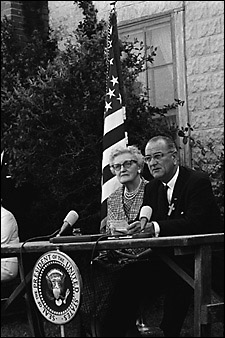The law and education, then and now
Educators discuss the ESEA, and its incarnations
A panel of educators met March 15 at the Graduate School of Education (HGSE) to discuss the 40-year history of the Elementary and Secondary Education Act (ESEA). The panel members agreed on the act’s beneficial impact on public education, but they could find little good to say about its most recent version, the Bush administration’s No Child Left Behind.
“The original act was all about educational equity, between black and white, girls and boys, rich and poor,” said HGSE Dean Ellen Lagemann, who moderated the discussion.

Lagemann spoke about the history of the act and about the man most responsible for drafting it and pushing it through Congress, Francis Keppel, former dean of HGSE and U.S. commissioner of education under Presidents Kennedy and Johnson. Appointed commissioner of education in 1962, Keppel managed to make legislative progress that had eluded his predecessors.
“There were many earlier proposals for federal funding of public schools, but all of them were blocked in the Congress. ESEA broke the logjam,” Lagemann said.
Robert Schwartz, lecturer on education at HGSE, continued the story with an explanation of how the logjam was finally broken.
Federal funding to education had been stalled primarily because its advocates had found it impossible to design a program that would be acceptable to private and parochial schools and to the segregated school systems of the South, Schwartz explained. The Civil Rights Act of 1964 forced Southern schools to integrate, thus eliminating one obstacle. It remained to Keppel to overcome the other.
“He was a pivotal actor at a crucial time,” Schwartz said. “He used his negotiating skills and powers of persuasion to bridge the gap between church and state.”
Keppel dealt with the concerns of private schools by shifting the focus of the program from funding for schools to aid that followed individual students, Schwartz said.
Catherine Snow, the Henry Lee Shattuck Professor of Education and an expert on language and literacy development in children, brought the discussion up to the present with an analysis of what she sees as some of the inadequacies of No Child Left Behind, signed into law by George W. Bush in 2001.
The new law places imperatives on state education departments to come up with new tests in math, reading, and language proficiency, requiring the administration of new tests every year for grades one through eight.
“Some people have called it ‘the test developer full employment act,’” Snow said.
In certain areas, she said, the federal law requires states to administer tests that do not yet exist in a satisfactory form.
“Most shockingly, it asks for a proficiency test for second language speakers of English to be administered every year. There is no decent test for this. Every state is going to have to come up with one,” Snow said.
The new law places a great deal of emphasis on research results, but Snow said that when it comes to reading, much of its reliance on research is misguided. The federal reading panel reviewed experimental research in reading and ignored other sources of knowledge. As a result, federal funding may be used only to support interventions based on this research.
“For example, many studies have shown that kids who read more, read better. That should be pretty obvious. But because the experimental evidence the panel looked at doesn’t show this connection, curricula that include more opportunities for reading are not endorsed. Clearly, the research base is inadequate.”
Another inadequacy of the law, Snow claims, is that it endorses the theory that higher expectations produce better results, but doesn’t take into account that students come to school with different levels of preparation. Moreover, the law minimizes the role of early childhood education, something that might help to correct these inequalities.
“In the absence of a level playing field, higher expectations are simply fantasy,” Snow said.
Dorinda Carter, a math teacher who is currently a student in the HGSE’s Ph.D. program, said that No Child Left Behind fails to address the crisis in teacher training. While there have been modest gains in math and reading since the law went into effect, the ambitious goals that have been set cannot possibly be reached unless the supply of good teachers is increased.
“We are so focused on testing and accountability that we are not focused on the most important aspect of education, the need for highly qualified teachers,” Carter said.
Nor is it enough for these teachers to simply teach their subject. Having teachers who reflect the racial, cultural, and linguistic diversity of their students is also important, asserted Carter, adding that while 40 percent of students are children of color, 90 percent of teachers are white.
“We can’t continue to have a racially homogenous teaching force to teach racially diverse students,” she said.




